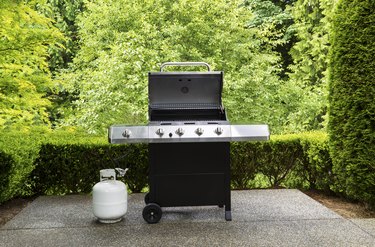
Butane and propane are types of liquified petroleum gas (LPG) that are often used as fuel to produce heat. Propane tanks are commonly used to fuel barbecue grills, small stoves, engines and home heating systems, while butane is often used for items like lighters, lanterns and mini craft torches. In addition, propane has higher pressure at a given temperature point than butane and is sold in bottles or cylinders, whereas butane typically comes in smaller canisters. Butane and propane share certain properties because they're both derived from petroleum and natural gas. However, these fuels have significantly different requirements for safe storage.
Storage Conditions for Butane
Video of the Day
Canisters of butane can be easier to store than propane bottles, since they're typically sold in smaller containers. Thanks to their small size, butane canisters can be stored together, individually boxed or wrapped in a protective sleeve, such as plastic foam or heavy cloth. Butane canisters also have federal labels affixed to them that outline safe storage conditions, such as maximum ranges of heat and cold. Safe temperatures for butane storage range from 32 to 125 degrees Fahrenheit. Butane requires a cool, dry, fireproof storage environment.
Video of the Day
Butane Storage Location
Butane must be stored indoors at all times. It should be locked away (if applicable) and kept out of reach of small children and pets. Due to their smaller size, butane canisters can be stored in large drawers, cupboards, garages, closets and utility storerooms. Butane cannot safely be placed in direct sunlight for any length of time, so the storage area should be dark and well protected from the sun's rays. Additionally, the storage area should not be in proximity to an electrical outlet, hot bulb, stove, toaster or any other type of heat source. Butane should not be stored in automotive vehicles.
Storage Conditions for Propane
Large propane bottles or cylinders can be stacked side by side on their bottoms or resting on their sides in wooden or metal containers that can keep them from rolling. If resting on their sides, their relief valves should be positioned above the liquid level of the bottles.
The storage areas for upright propane bottles should have a hard, flat surface, such as concrete or stiff wooden flooring that has proper drainage for water runoff. Propane must be located away from high-traffic areas and any open flames or ignition sources, such as generators or heaters. Propane bottles should be clearly marked with stickers or placards on their exterior shells.
Propane Storage Location
Because of its lower boiling point and higher pressure point than butane, propane should be stored outside the home in an area with good ventilation. Bottled propane can withstand harsh weather conditions and temperatures for prolonged periods.
Propane cylinders should not rest on grass, mud or dirt, where moisture combined with oxygen can react with the metal tank components to cause rust. If tall cylinders need to be stored upright and near each other, they should be braced with bungee cords or thick duct tape to prevent them from falling.